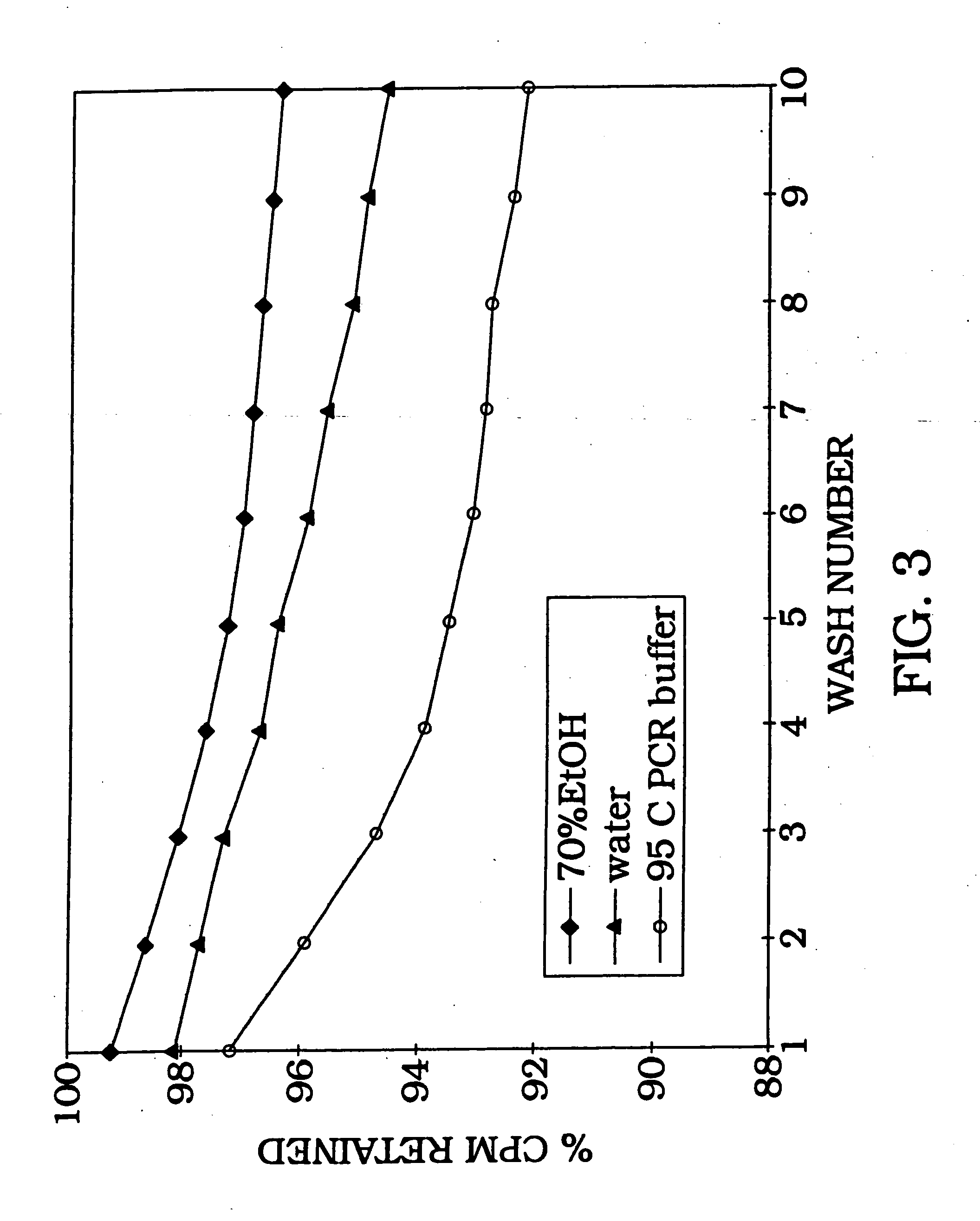Nucleic acid archiving
a technology of nucleic acid and archiving, applied in the field of nucleic acid archiving, can solve the problems of significant cross-contamination chance of specimens, laborious nucleic acid analysis, and difficult, if not impossible, to obtain a second confirmatory specimen
- Summary
- Abstract
- Description
- Claims
- Application Information
AI Technical Summary
Benefits of technology
Problems solved by technology
Method used
Image
Examples
example 2
Confirmation of Tight Binding of DNA to Solid Phase Matix
[0101] Radiolabeled DNA (1 ng) is allowed to bind with aluminum oxide at room temperature, with rotation, for 1 hour in water (ddH.sub.2O), 0.1 N NaOH, or 4 M guanidine thiocyanate buffer. In order to estimate binding capacity of 198 mg aluminum oxide, 1 ng of radiolabeled DNA was added to various concentrations of salmon sperm DNA (FIG. 2). As the amount of salmon sperm DNA is increased, the percent of DNA bound gradually decreases as DNA binding reaches as maximum and additional solution phase DNA cannot bind. The irreversibility of DNA binding is shown by counting the radiolabel removed following 10 sequential washes (FIG. 3). As illustrated in FIG. 3, the DNA remains tightly bound with greater than 92% retention following 10 washes with 95.degree. C. PCR buffer. The majority of eluted counts (6%) occur during the first four washes with only a 2% total elution during the last six washes. Therefore, the data in FIG. 3 demons...
example 3
[0102] Significant improvement in the sensitivity of DNA detection from specimens of high volume and low concentration is derived based on the capability of aluminum oxide to efficiently bind DNA at high flow rate by chromatography. Radiolabeled DNA was allowed to bind during gravity filtration of either 74-149 .mu.m aluminum oxide beads (Al.sub.2O.sub.3) or 150-212 .mu.m silicon dioxide beads (SiO.sub.2) (Sigma, catalog No. GI 145). The amount of silicon dioxide or aluminum oxide was adjusted such that they both have equal surface area available for DNA binding. DNA (50 ng) bound during gravity filtration when diluted in either 1 mL guanidine thiocyanate binding buffer (1.5-2 minutes flow time, approximately 0.5 mL / min) or 10 mL guanidine thiocyanate binding buffer (5-8 minute flow times, approximately 2 mL / min). FIG. 4 compares the effect of flow rate and concentration on DNA binding to silicon dioxide versus DNA binding to aluminum oxide. Aluminum oxide...
example 4
Solid Phase Amplification
[0104] Since aluminum oxide tightly binds nucleic acid, aluminum oxide is only useful if the bound DNA can be amplified directly on the solid phase. In order to illustrate compatibility with different amplification methods, 10.sup.6 copies of HIV DNA and 1 .mu.L of a plasmid prep of mycobacterium DNAs were simultaneously bound to aluminum oxide in water. These bound DNA targets were then amplified in sequence with HIV, initially amplified using 35 cycles of polymerase chain reaction (PCR) (see FIG. 5, panel "a"), followed by amplification of the mycobacterium target via strand displacement amplification (SDA) (see FIG. 5, panel "b"). An ethidium bromide (EtBr) stained agarose gel of the HIV PCR, shown in FIG. 5, panel "a" exhibited excellent amplification product. In FIG. 5, panel "a", well 1 is a molecular weight ladder, wells 2 and 3 are positive aqueous 1000 copy control amplifications, wells 4, 5, 6 and 7 are aluminum oxide solid phase PCR amplifications...
PUM
| Property | Measurement | Unit |
|---|---|---|
| concentration | aaaaa | aaaaa |
| size | aaaaa | aaaaa |
| volumes | aaaaa | aaaaa |
Abstract
Description
Claims
Application Information
 Login to View More
Login to View More - R&D
- Intellectual Property
- Life Sciences
- Materials
- Tech Scout
- Unparalleled Data Quality
- Higher Quality Content
- 60% Fewer Hallucinations
Browse by: Latest US Patents, China's latest patents, Technical Efficacy Thesaurus, Application Domain, Technology Topic, Popular Technical Reports.
© 2025 PatSnap. All rights reserved.Legal|Privacy policy|Modern Slavery Act Transparency Statement|Sitemap|About US| Contact US: help@patsnap.com



